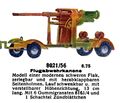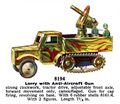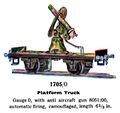Category:Anti-Aircraft units
Anti-Aircraft units and hardware.
1919 commentary
Anti-Aircraft Devices
BEFORE the War broke out, means to combat hostile aircraft had not been very thoroughly considered. Every nation had issued laws denying the right of foreign craft to fly over any other country how and when it pleased. Local authorities had taken similar measures to prevent aircraft flying over thickly populated districts, but nobody had thought out clearly by what means these laws and by-laws were to be enforced. You cannot take an aeroplane's number as easily and simply as that of a defaulting taxi-cab or motor-car.
With the War came a far more difficult problem than just fining as a protest the trespassing aircraft. It became more than a mere policeman's job when hostile aircraft flew over England, dropping bombs to kill peaceful inhabitants and destroy property. At first the only weapon of defence was the rifle, to be superseded shortly by a hastily converted high-angle gun, with inefficient sighting arrangements and ammunition. Hasty provision had to be made to meet. an emergency that no one had foreseen.
The first thing was to design a gun-mounting which would enable the weapon to fire directly overhead. This in itself was a problem of some complexity, because no modern gun had fired at a greater angle of elevation, than from 10 to 15 degrees, and to fire at 90 degrees was a big alteration. Having got a gun with sufficient elevation, it became necessary to design a new kind of sight with which to aim accurately at moving aircraft. In the early days it was considered near enough to aim at an aeroplane as if shooting at a fast-flying bird; the gunner pulled the trigger and hoped for the best, and the best was generally a miss. With a greatly improved "sight," the shooting became better; but an aeroplane will always be difficult to hit, because the pilot has a bad habit of altering his course just as you pull the trigger, and since a shell takes some time in flight, it generally arrives in the place where the aeroplane should be, but isn't.
Not only was it necessary to obtain an efficient sight, but the question of range came into the problem; and by "range" we have to include not only distance but height. That necessitated a special range-finder to be designed, constructed and brought into intelligent use. Then, having found his range and gauged the speed of the aircraft, the gunner had to set his fuse on the shell so that it should burst, if possible, exactly on the object. All these problems had to be worked out, the various sights, fuses, etc., set and the gun loaded and fired, all within a very short space of time. Consequently the human element, which was the most important part of the combination, had to be highly trained. All this took time, and during that time the raiding enemy had things in the air very much his own way.
When it came to shooting at airships another curious problem arose; how to get a shell to hit and to explode on the skin of a Zeppelin. It was found by bitter experience that the best shooting in the world had little effect on a fast travelling airship, because the air stream running from the nose aft formed a sort of cushion which deflected even the heavier type of shells. This trouble was never entirely overcome; consequently the gun was not considered to be the best weapon to employ against airships. The gun is good against an aeroplane, if only one can be sure of hitting it in a vital spot, but the average aeroplane can be fairly riddled with shrapnel, its tank pierced, its wings made to look like sieves, both pilot and observer injured, and yet be able to flyaway home. Really the only true function of the anti-aircraft gun is to keep a raiding aeroplane or airship at such a height, from fear of being vitally wounded, that the pilot and observer are more concerned about their own safety than about the bombing of those below, and also to make any attempt at bombing a particular place or locality an extremely difficult matter.
Beyond the power of seeing an aircraft, we have the power of hearing, and of the two the latter is the more important; because, whatever the weather conditions, if aircraft can fly they can be heard, and to hear is to be warned, and that is a long way towards efficient defence. Sound, however, plays all sorts of pranks under particular conditions, especially in fog, or when certain types of clouds are about. But the anti-aircraft defence forces had latterly certain sounding machines which were as nearly perfect as possible, and they played a most important part not only in warning but in directing the gunners.
An aeroplane raid during a brilliant moonlit night presented many difficulties to the defence, because searchlights, good and greatly improved as they were, are no match for the moon, and an aeroplane flying at a great height can neither be picked out by the searchlight, nor seen with the naked eye, and hardly with glasses.
But, after all, the material devices we possessed for combating the terror that flew by night would have been of little avail without our gallant airmen. Guns, listening-posts, searchlights, and other weapons and appliances are all means to an end, to scare, annoy and keep off enemy aircraft; but it is better to destroy than to scare, and for this we had to depend more and more on the aviators themselves. It is one of the hardest things in the world to hit a moving aeroplane, though it was often done. But everyone knows how our airmen accounted for Zeppelins, time after time, and no one could keep count of the enemy aeroplanes that were brought down. So that, when all has been said, the only really sure and efficient anti-aircraft device is the British airman, a real live product of these Islands and of the Dominions, and not a machine.
— , Henry Halling, , The Wonder Book of Aircraft, second edition, , 1919
1920s
By the mid-1920s, mobile coastal anti-aircraft systems might consist of (a) a sound-locator team with listening horns, (b) a height-finder team with a special nine-foot custom range-finding telescope, () a searchlight team equipped with a searchlight with a special long tilt-and-swivel handle, and of course (d) the Anti-Aircraft guns. Sometimes (e) a Predictor was also used, a mobile analogue computer that could quickly take in height, direction and range information and control a gun that could then fire shells on an intercept course for the aircraft's expected future position.
Some teams would also be able to deploy barrage balloons to make a target less attractive to attack, especially to dive-bombers.
1930s
By the mid-1930s, the audio spotting teams were increasingly being replaced by a set of new (and very secret) radar installations that could give advance warning of attacks, so that interceptor aircraft could be mobilised.
Subcategories
This category has the following 5 subcategories, out of 5 total.
A
- Astra Pharos Ltd (5 P, 18 F)
B
M
- Mobile Anti-Aircraft Unit (Dinky Toys 161) (1 P, 2 F)
O
- Observation and Barrage Balloons (2 P, 9 F)
S
- Skybirds Anti-Aircraft (1 F)
Pages in category ‘Anti-Aircraft units’
The following 15 pages are in this category, out of 15 total.
M
S
T
Media in category ‘Anti-Aircraft units’
The following 36 files are in this category, out of 36 total.
- 20mm Oerlikon Anti-Aircraft Gun (Astra Pharos).jpg 1,600 × 1,386; 163 KB
- 20mm Oerlikon Anti-aircraft Gun, profile (Astra Pharos).jpg 1,600 × 1,536; 178 KB
- 3-7 Anti-Aircraft Gun, Astra Pharos model 18 (MM 1940-07).jpg 3,000 × 1,900; 523 KB
- A three-lobed Kite Balloon (WBoA 4ed 1920).jpg 2,038 × 3,000; 1.21 MB
- Anti-Aircraft Gun, Meccano Multikit (MCMBM 1975).jpg 3,000 × 2,122; 4.1 MB
- Anti-Aircraft Gun, Model No6 (Nicoltoys Multi-Builder).jpg 1,200 × 715; 103 KB
- Astra anti-aircraft station ad (1939-08).jpg 746 × 973; 193 KB
- Astra Pharos model searchlight, Selfridges (MM 1947-11).jpg 1,488 × 2,092; 432 KB
- Astra Pharos quarter-mile beam searchlight ad 1939.jpg 558 × 738; 160 KB
- Astra Pom-Pom Gun, box lid.jpg 2,400 × 1,037; 642 KB
- Astra searchlight models (MM 1938-11).jpg 1,170 × 1,495; 505 KB
- Barrage Balloon Section, box lid (Britains 1749).jpg 967 × 2,400; 550 KB
- Barrage Balloon Unit, Britains 1855 (BritCat 1940).jpg 2,220 × 1,585; 201 KB
- Flugabwehrkanone - Anti-Aircraft Gun, Märklin 8021-56 (MarklinCat 1939).jpg 1,465 × 1,255; 632 KB
- Flugzeug Abwehrgeschütz - Anti-Aircraft Defences Gun, Märklin 8050 (MarklinCat 1931).jpg 1,562 × 1,116; 537 KB
- Height Finder, Britains 1729 (BoxLab 1939).jpg 2,389 × 2,400; 351 KB
- Instructions for Assembling the Barrage Balloon, p1 (Britains 1749).jpg 2,040 × 2,400; 736 KB
- Instructions for Assembling the Barrage Balloon, p2 (Britains 1749).jpg 2,043 × 2,400; 766 KB
- Lorry with Anti-Aircraft Gun, Märklin 8194 (MarklinCat 1936).jpg 1,657 × 1,431; 325 KB
- Meccano Mechanised Army Outfit (MM 1941-01).jpg 1,202 × 1,600; 404 KB
- Mobile Anti-Aircraft Unit, Dinky Toys 161 (HamleyCat 1939).jpg 1,998 × 952; 818 KB
- Mobile Anti-Aircraft Unit, Dinky Toys 161 (MLtdCat 1939).jpg 821 × 501; 103 KB
- Observation balloon above a town (WBoA 4ed 1920).jpg 3,000 × 2,298; 1.96 MB
- Observation Balloon Ascending (WBoA 4ed 1920).jpg 3,000 × 2,354; 1.67 MB
- Platform Truck with Anti-Aircraft Gun 8051, Märklin 1705 (MarklinCat 1936).jpg 1,429 × 1,346; 226 KB
- Predictor with operator, Britains 1728 (BoxLab 1939).jpg 2,025 × 2,400; 403 KB
- Range Finder, Britains 1639 (BoxLab 1938).jpg 1,798 × 2,400; 262 KB
- Scale Model Balloon Barrage with Clockwork Winch Lorry, Minic (MM 1940-07).jpg 2,816 × 3,000; 609 KB
- Searchlight, Britains 1640 (BoxLab 1938).jpg 2,400 × 1,500; 250 KB
- Skybirds Anti-Aircraft Section, label artwork (Skybirds).jpg 3,000 × 1,817; 721 KB
- Sound Locator, Britains 1638 (BoxLab 1938).jpg 2,400 × 2,156; 205 KB
- Spotting Chair and Observer, Britains 1731 (BoxLab 1939).jpg 2,400 × 1,780; 411 KB
- Two-Pounder AA Gun on Mobile Chassis (Britains 1717).jpg 2,179 × 2,400; 327 KB
- Underslung Lorry with Driver (Britains 1641).jpg 2,400 × 835; 618 KB




































